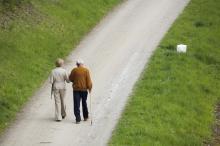Physical activity appears to protect against cognitive impairment in the elderly, according to two separate studies reported online July 19 in the Archives of Internal Medicine.
In both studies, even light physical activity such as walking and doing housework were associated with better preservation of cognitive function than was inactivity, the investigators said.
In the first study, researchers used an objective measure of activity energy expenditure to examine the relationship between even the lightest forms of activity and incident cognitive impairment in late life. Activity energy expenditure (AEE) captures energy expended on motions from fidgeting and changing posture to jogging and biking, said Laura E. Middleton, Ph.D., of the Heart and Stroke Foundation Centre for Stroke Recovery at the Sunnybrook Health Sciences Centre, Toronto, and her associates.
"It may be particularly important to capture low-intensity physical activity in elderly individuals, who are less likely to perform vigorous physical activity," they noted.
The AEE technique was used to assess a subgroup of 197 older white men and women (mean age, 75 years) who participated in the Health ABC (Aging and Body Composition) study. They were free of physical and cognitive impairment at baseline in 1998-1999. The participants’ global cognitive function was assessed using the 3MS, a brief test of orientation, concentration, language, praxis, immediate memory, and delayed memory.
During 2-5 years of follow-up, the likelihood of developing cognitive impairment was strongly associated with AEE in a dose-dependent fashion. The incidence of cognitive decline was 1.5% in subjects in the highest tertile of AEE, 4.5% among those in the middle tertile, and 16.9% in those in the lowest tertile of AEE.
This association remained robust through several further analyses, including one that controlled for factors known to influence activity level, such as fat-free body mass. In fact, the association between cognitive impairment and the simple daily motions of climbing stairs or caregiving was even stronger than that reported in previous studies for vigorous physical activity such as running, Dr. Middleton and her colleagues reported (Arch. Intern. Med. 2011 July 19 [doi:10.1001/archinternmed. 2011.277]).
In the second study, another group of researchers examined the association between physical activity and cognitive decline using data from a subgroup of 2,809 older women participating in the Women’s Antioxidant Cardiovascular Study. The study subjects were women health professionals aged 65 or older who had cardiovascular disease, three or more coronary risk factors, or a parent with a history of premature MI or CVD.
Cardiovascular disease and coronary risk factors markedly raise the risk of cognitive impairment. But previous studies that sought to determine whether physical activity would protect against such decline in these high-risk patients have yielded inconsistent and inconclusive results, said Marie-Noel Vercambre, Ph.D., of Mutuelle Generale de l’Education Nationale, Paris, and Brigham and Women’s Hospital, Boston, and her associates.
In this study, the women reported their physical activity and underwent a battery of cognitive tests by telephone interview every 2 years during approximately 6 years of follow-up. Greater physical activity was strongly and consistently associated with substantially slower cognitive decline. "Participating in the 2 highest quintiles of physical activity [the equivalent of walking 30 minutes per day at a brisk pace] was cognitively equivalent to being 5-7 years younger," Dr. Vercambre and her colleagues wrote.
"Most important, the association with total physical activity was not restricted to women engaged in vigorous exercise." Even women who never participated in any vigorous activity showed cognitive benefit from simple walking, they noted (Arch. Intern. Med. 2011 July 19 [doi:10.1001/archinternmed.2011.282]).
It is important to note that physical activity did not correlate with baseline vascular disease in these study subjects, so there was little chance that the findings were confounded by the severity of their CVD, the investigators added.
If these findings are confirmed in future research, "physical activity recommendations could yield substantial public health benefits, given the growing number of older persons with vascular conditions and their high risk of cognitive impairment," Dr. Vercambre and her associates wrote.
They added that several mechanisms may underlie physical activity’s protective effect on the brain. "Exercise may directly preserve neuronal structures by stimulating brain-derived neurotrophic factor and neuronal growth, possibly providing reserve against cognitive decline and dementia. Exercise may also have indirect effects by strengthening the underlying systems that support brain plasticity and helping to sustain the brain’s vascular health by beneficially influencing cardiovascular risk factors, promoting endothelial function, improving glucose and insulin regulation, and ensuring adequate cerebral perfusion.


